牛背山志愿者之家,蒲麦地,四川,中国
2015-12-19建筑设计李道德深度建构建筑设计有限公司
建筑设计:李道德/深度建构建筑设计有限公司
牛背山志愿者之家,蒲麦地,四川,中国
建筑设计:李道德/深度建构建筑设计有限公司

1 外景/Exterior view
这个项目是受东方卫视邀约的一次公益设计,为一群年轻的志愿者们在大山里盖一座房子,地点在四川省甘孜藏族自治州泸定县蒲麦地村。缘起于成都的资深义工大雁和他的一群90后小伙伴们在牛背山的一次旅行。被誉为中国最美观云海之地的牛背山,有很多驴友徒步登山,但是由于还没有被开发,基础设施极为落后,存在很多隐患,救援又无法及时达到。蒲麦地村是离牛背山顶最近的一个有人居住的小村落,村子基本呈现出中国西南地区传统的乡村面貌,坡屋顶、小青瓦,民风淳朴。正如中国大部分的偏远村庄一样,成年的劳动力大都在城市打工,村里更多的是留守儿童和空巢老人,很多村舍年久失修。大雁他们希望在这里建造一个供年轻人公益实践的基地,在帮助遇险的驴友的同时,也可以为村里的老人、儿童提供服务和帮助。为了保证公益实践的开支,他们也需要这个房子有一定的青年旅社的功能。
改造前的房子是一个传统的破旧民居,门前一个被当地叫做“坝子”的平台,木结构坡屋顶,但瓦已坏,平台上的首层空间被厚重的墙体分割成几个昏暗的小房间,屋顶阁楼已破旧不堪,没有厕所、厨房,在坝子的南侧有一个农民后来自己加建的方正的砖房,与环境极不协调且不抗震。我们的改造策略是在完善基本使用功能的前提下,让这个建筑更具有开放性与公共性,可为更多的人群服务,从建筑空间与结构上进行创新的同时,又具有中国传统建筑的记忆与灵魂,使其与村落、与环境相协调,融为一体。
于是,我们在一层保留并加固了内部的木结构,拆除了面向坝子的厚重墙体以及内部隔墙,使一层完全开放,作为最重要的公共空间,可作为读书阅览、酒吧、会议等多种功能。重新设计的钢网架玻璃门,可以存储木柴,在完全打开的时候,将室内外融为一体。坝子北侧的破旧猪圈被拆除,保留了木结构和坡屋顶,加建了围墙以及下水排污设施,改造为厨房和淋浴间以及卫生间,这也是整个村子唯一的一处有抽水马桶的卫生设施。我们拆除了坝子南侧后建的砖房,还原了坝子原本的空间,并加建了一个木结构的构筑物,顶部覆瓦,可遮风避雨,增大了坝子使用率的同时,也形成了一个独特的观景平台。
在这个项目中,我们尽可能地使用当地村民作为主要的劳动力,使用最常见、最基本的建筑材料和传统的搭建方式,比如当地石块的砌墙方式、坡屋顶与小青瓦的延续。当然,在加建的构筑部分,我们采用了数字化的设计方法与生成逻辑。面对主屋你可以看到从左至右,逐渐由传统转变到了现代、甚至是对未来的探索。一个和背后大山、云海相呼应的有机形态的屋顶呈现了出来。内部看似是传统的木结构,但又是一种数字化的全新表现。这里所采用的材料也是由四川本地盛产的慈竹所提炼而成的新型竹基纤维复合材料,具有高强度、耐潮湿、阻燃等特性,可循环再生,低碳环保。但对这种异形结构的加工,供应商也是首次尝试,结合建筑师的模型、图纸在施工现场放样加工,工厂预制与现场手工相结合。这个起伏的屋顶与背后的大山以及远方的云海之间存在着形式上的某种关联,但我们更希望营造的是内心与情感上的联系,当驴友或者志愿者,甚至是村民们,徒步多时至此,远远可以看到村口有这么一个小小的独特而又熟悉的建筑泛着微微的暖光,就像是航船在大海航行中看到了灯塔,是给人们的一个召唤与鼓励,有着一种强烈的归属感。
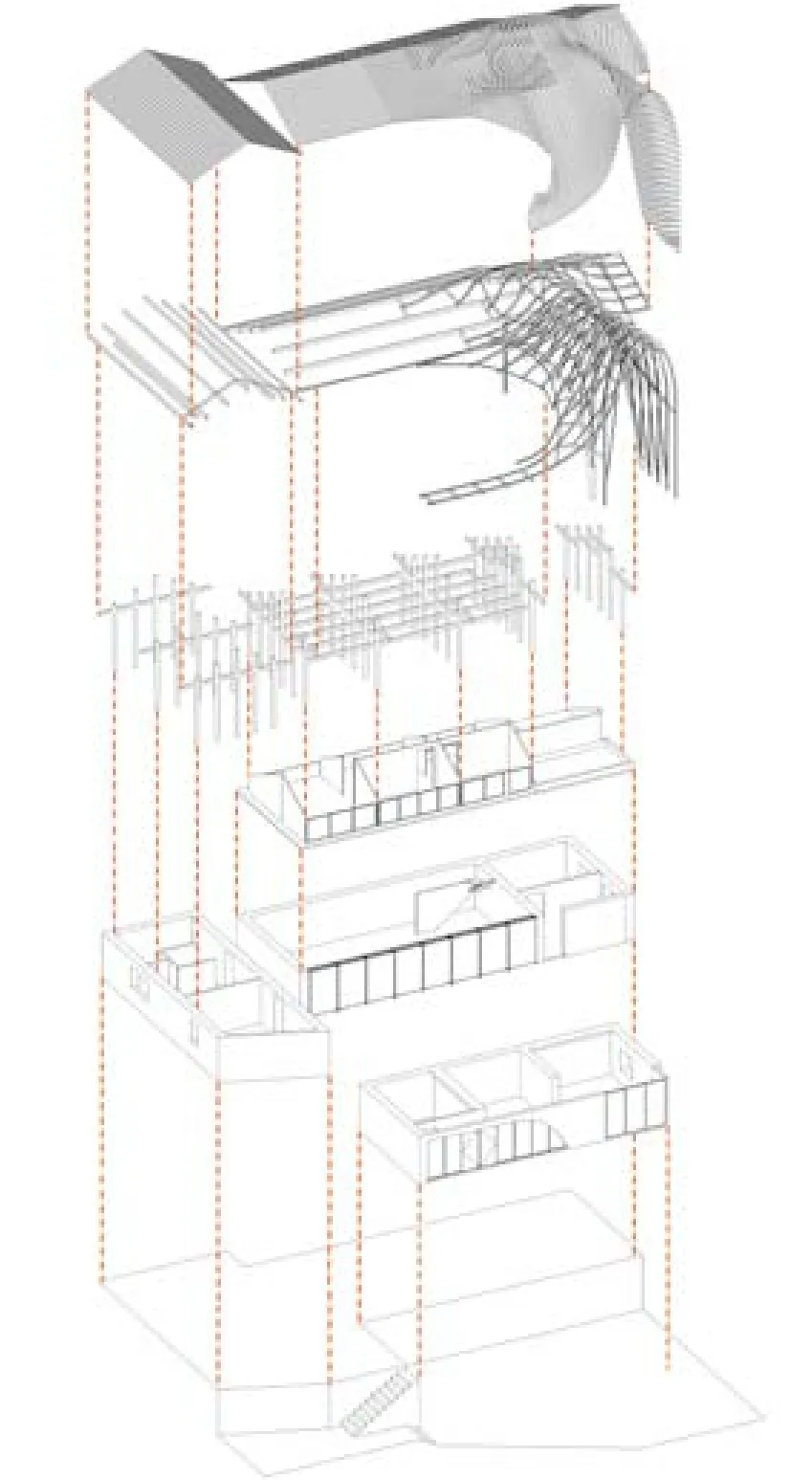
2 概念轴测图/Concept diagram

3 改造前/Before reconstruction
Organized by Dragon TV, the Cattle Back Mountain Volunteers' House is a social welfare project dedicated to a group of young volunteers. It is located in the mountain of Pumaidi Village, Luding County, Sichuan Province. Known as the best viewing platform for the sea of clouds, Niubeishan is visited by a large number of travelers and explorers every year. However, being underdeveloped, the infrastructure and public service here still much lag behind. There exists much hidden danger and rescue is often delayed. Pumaidi Village, the inhabited village closest to Niubeishan, is a typical village of Southwest China, with pitched roofs, grey tiles and a harmonious living environment. Like most of the villages in the remote areas in China, the majority of the population is composed of the elderly and the children as the young and the strong are working in big cities. Most of the houses are old and seriously lacking in maintenance. With such a consideration, Dayan, an experienced volunteer, decided to build a base here for the youth to practice social services, and to provide help for the travelers in need as well as the elderly and the children of the village. The house would also serve as a youth hostel so as to balance the budget for social services.
Before renovation, the building was a broken traditional house with wooden pitched roof of broken tiles. In front of the house there was a platform (called "Bazi" by the local). The space on the first floor of the platform was divided by thick walls into several dark rooms. The loft on the rooftop was old and shabby, with no kitchen or bathroom inside. In the south of the platform, there was a square brick house built by the farmers at a later time, which was neither harmonious with its surrounding nor seismic resistant. Under the premise of improving the basic functions, we intended to make the building more open to the public and capable of serving more people. From the viewpoint of architectural space and structure, we hoped to promote innovation while at the same time trying to retain the flavor and the soul of Chinese traditional architecture, so that the building would be successfully integrated into the village and its surroundings.
项目信息/Credits and Data
主创建筑师/Principal Architect:李道德/LI Daode
设计团队/Design Team:李道德,张灿,郑钰,曹博,陈海生/LI Daode, ZHANG Can, ZHENG Yu, CAO Bo, CHEN Haisheng
设计时间/Design Period:2014.07-2014.09
功能/Program:志愿者之家,青年旅社,书吧,咖啡吧,志愿者办公空间,医疗室等/Volunteers' House, youth hostel, book and cafe bar, volunteers' office, clinic, etc.
建筑面积/Floor Area:300m2
建筑材料/Materials:当地石材,瓦,竹基纤维复合材料/ Local stone, clay tiles, wooden bamboo
摄影/Photos:dEEP

4 立面/Elevation

5 细部/Detail
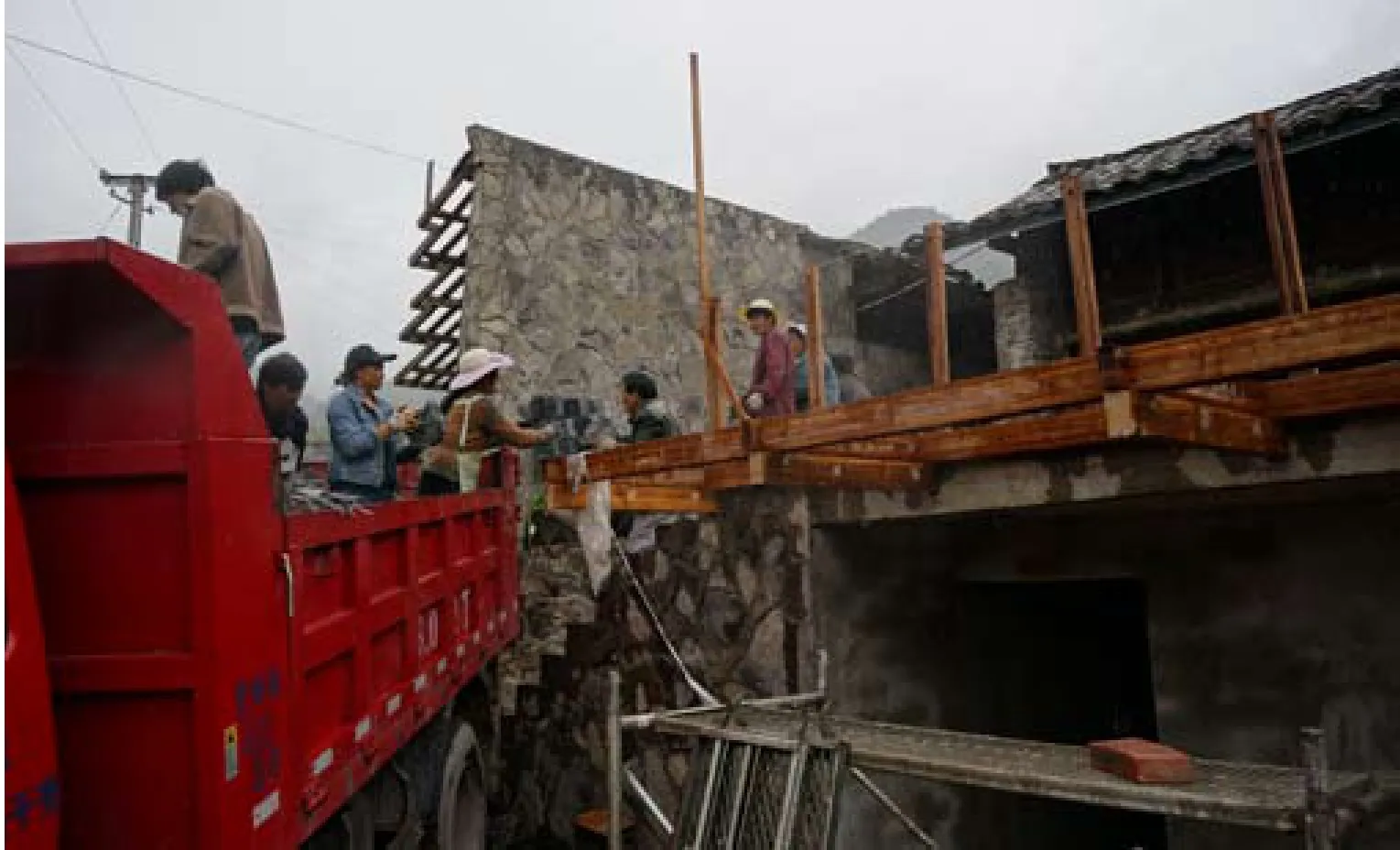
6 施工现场/Building in construction
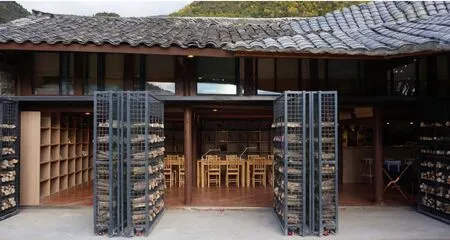
7 外景/Exterior view
Therefore, on the first floor we kept and strengthened the inner wood structure, got rid of the thick wall that was facing the Bazi and all the internal partitions to make the first floor completely open and serve as an important public place where people could read, get together or grab a drink. The new steel-net-framed glass door could be used to store firewood. When completely open, the interior and exterior space emerged into one. The old pigsty in the north of the Bazi was removed while the wood structure and the original roof were reserved. With walls added and sewage system installed, the place was transformed into a kitchen and a bathroom. It was the only place with flush toilets in the whole village. We also removed the brick house in the south of the Bazi and replaced it with a wood structure with tile roof, making it a shelter from wind and rain. With all the above efforts, we maximized the use of the Bazi and turned it into a unique viewing platform.
In the project, we used the most basic architectural materials and traditional building techniques (stone walls of the local style, pitched roofs and grey tiles that consisted with the original architectural language), and we tried our best to make full use of the local labor force. Digital design method and generative logic were applied in the building of the added structure. When facing the main facade, from left to right, one was able to see an organic roof emerging from the mountain and the clouds, a perfect transition from tradition to modernity, or even an exploration of the future. As for the internal space, it's a brand new expression of wood structure in digital times. The wooden material used in the project was produced locally in Sichuan, a new type of bamboo-based fiber composite with high resistance to strength, moisture and fire, which was also recyclable and environmentally friendly. It was the first endeavor of the supplier to process materials for architecture of irregular shape. It involved sample making according to the models and drawings of the architect and manual adjustments of the prefabricated parts on site. There is certain relevance between the curved roof, the mountain in the back and the sea of clouds, but we are more eager to create relevance between the heart and the mind. When travelers, volunteers or even the villagers approach from afar, looking at this unique and familiar building that shimmers with warmth, they will be seized by the sense of belonging, as if a sailing ship spots a light tower that gives it immediate courage to move forward.
评论
方晓风:对于一个大众媒体主导的公益项目而言,这可能是非常理想的结果。建筑师有机会炫耀自己娴熟的专业技能,而媒体可以借此讲述一个高反差的建筑故事。但设计背后所透露出的气息并不那么讨人喜欢,低眉顺眼的穷亲戚是否真认这个好,殊可怀疑,而城里人是否有必要如此显摆?这可能是诛心之论,并不可取。好吧,你得承认,这是一个很酷的姿态。
鲁安东:山那边人家
这是一个大山中的家,一个象征性的空间。经过艰难徒步,看到远方灯火,激起情感上的归属感,就像路亭、驿站或者灯塔。一层三维复杂曲面用传统符号进行了诗意而巧妙的伪装:起伏的屋顶搭在现有屋顶上,仿佛发生了某种变异;而新的纤维复合材料则像是传统的木结构,却提供了新颖的形态可能性。作为一个媒体策划的公益项目,这个建筑注定面向外界。

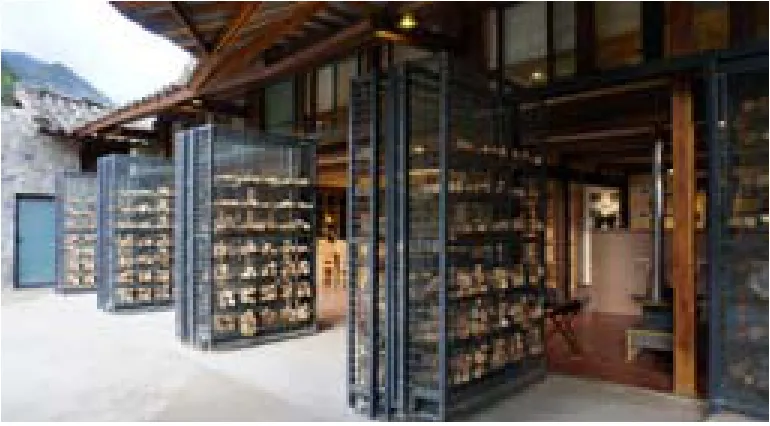
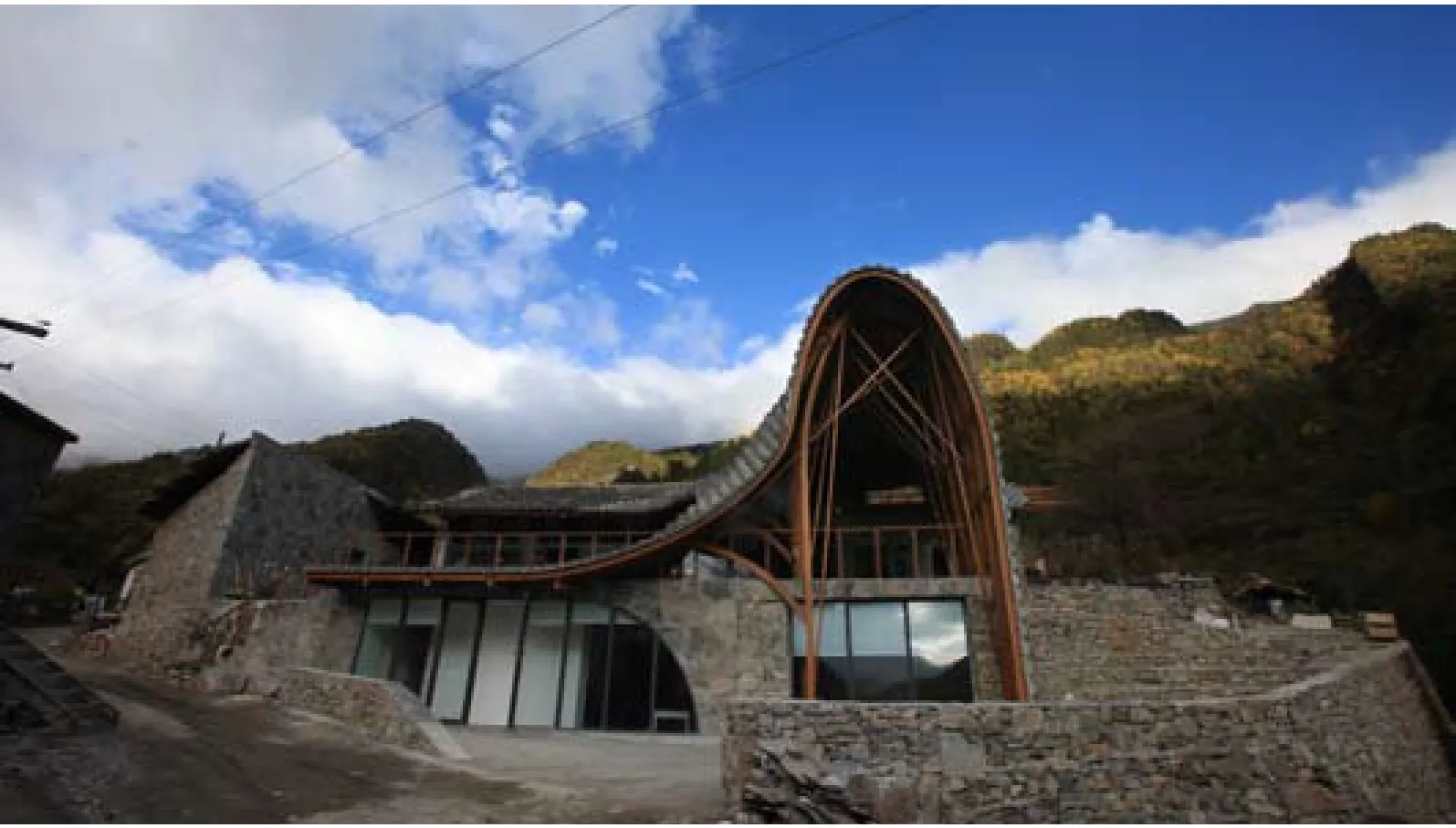
8-10 外景/Exterior views

11 原二层平面/Original floor 1 plan
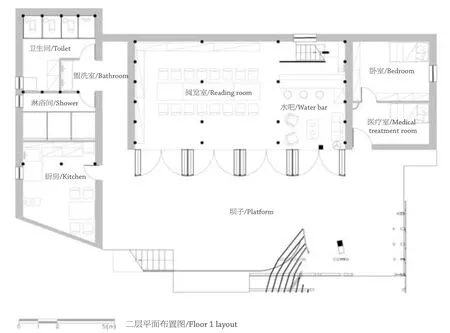
12 改造后二层平面/Floor 1 plan after reconstruction

13 内景/Interior view

14 剖轴测/Axonometric
Comments
FANG Xiaofeng: For a public welfare project driven by mass media, this is probably an ideal result. While the architect has the opportunity to show off his sophisticated professional skills, the media can use it to tell a story about a highly-contrasted building. However, the aura behind the design does not seem to be so likable: it is questionable whether its goodness can be recognized by the poor and obedient neighbors, or whether it is necessary for urban people to show off in this manner. This comment might concentrate too much on its motivation and is not desirable. Well, you have to admit that this is a cool POSE.
LU Andong: A home beyond the mountains
This is a "home" in the mountains, a symbolic space.The sight of the lights in the distance will elicit a strong sense of belonging from the travelers after difficult hiking, like a roadside pavilion, a tavern or a lighthouse usually does. The three-dimensional curved surface is poetically disguised with traditional metaphors: the curved roof covers and merges with the original roof, as if the latter had experienced a certain kind of mutation; the new fiber composite resembles traditional wooden structure but produces innovative potentials of new forms. As a welfare project organized by media, this architecture is destined to face the outside world.
Cattle Back Mountain Volunteers' House, Pumaidi, Sichuan, China, 2014
Architects: LI Daode/dEEP Architects
